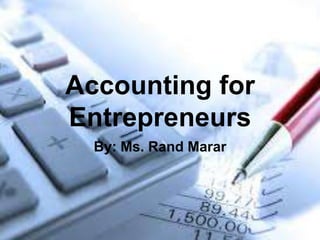
Accounting for entrepreneurs
- 1. Accounting for Entrepreneurs By: Ms. Rand Marar
- 2. What is Accounting? "The process of identifying, measuring and communicating economic information to permit informed judgments and decisions by users of the information.” - The American Accounting Association. -
- 3. Four Fields of Accounting • Financial Accounting. • Management Accounting. • Auditing. • Tax Accounting.
- 4. Why do we need Accounting? 1. Financial health. 2. Financial planning. 3. Budgeting. 4. Calculating tax liability. 5. Financial reporting. 6. Need for financing.
- 5. The Elements of Accounting Assets Items with money value that are owned by a business Ex. Cash, Building, Office Supplies…etc.
- 6. The Elements of Accounting (Cont’d) Liabilities Liabilities are debts owed by the business Ex. Loans, Accounts Payable…etc.
- 7. The Elements of Accounting (Cont’d) Owner’s Equity Capital, proprietorship, or net worth
- 8. The Accounting Equation! Owner’s Assets = Liabilities + Equity This equation must always balance!
- 9. The Accounting Cycle: Definitions • Transaction: A transaction is any activity that changes the value of a firm’s assets, liabilities, or owner’s equity • Account: is an individual record or form to record and summarize information for each asset, liability, or owner’s equity transaction. • Double-entry accounting: means that there will be at least two (2) accounts affected by each transaction.
- 10. The Accounting Cycle Definitions: • Journal: diary of information of day-to-day transactions. • Ledger: individual accounts that help summarize activity and obtain balances of accounts. • Trial Balance: a statement listing on a certain date that shows all accounts and their balances. This usually occurs at the end of the month, but it could be any time.
- 11. The Accounting Cycle 1. Analyze transactions. (Debit or Credit and when?) 2. Record in a journal.(Record) 3. Post from the journal to the ledger.(Summarize) 4. Prepare a trial balance of the ledger.
- 13. 2. Journal
- 15. 4. Trial Balance
- 16. 5. Financial Statements 1. Income Statement (contains only revenue and expenses and shows net gain or loss) 2. Statement of Owner’s Equity (summarizes the changes during the accounting period) 3. Balance Sheet (lists a firm’s assets, liabilities, and owner’s equity).
- 17. Income statement
- 18. Statement of Changes in Owner’s Equity
- 19. Balance Sheet
- 20. Users and Their Information Needs 1. Investors 2. Employees 3. Lenders 4. Suppliers and other trade creditors 5. Customers 6. Governments and their agencies 7. Public
- 21. Financial Ratios
- 22. Liquidity Ratios • Current ratio = current assets / current liabilities • Quick ratio = (cash + marketable securities + net receivables) / current liabilities
- 23. Leverage Ratios • Debt-to-asset ratio = total liabilities / total assets • Debt-equity ratio = long-term debt / shareholder's equity
- 24. Profitability Ratios • ROA = net income / total average assets • ROE = net income / total stockholders equity
- 25. Thank You
